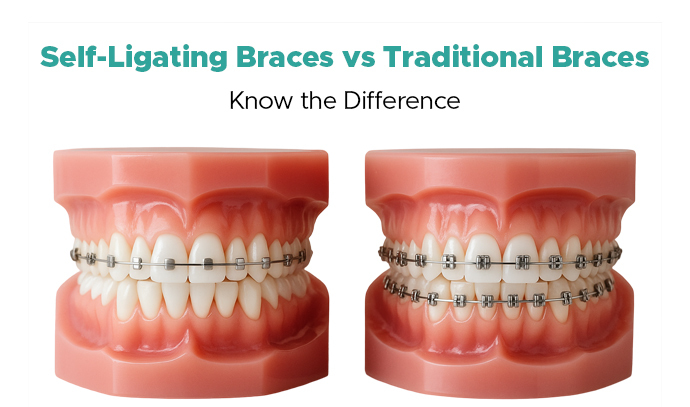
Self-Ligating Braces vs Traditional Braces – Know the Difference
Braces have come a long way from being chunky, metal-heavy devices to smarter, sleeker solutions. If you’re exploring braces options, you’ve likely to come across two popular choices – traditional braces and self-litigating braces.
Unlike traditional braces that use metal brackets and elastic bands for alignment, self-litigating braces eliminate the need of elastic by using specialized brackets with built-in clips. Moreover, self-litigating braces, as compared to the traditional braces, are easier to clean and more comfortable.
If you’re trying to decide between self-ligating braces vs traditional braces, this guide is exactly what you need. Whether you’re planning for yourself or a family member, choosing the right braces can make a big difference in comfort, treatment time, and maintenance.
Keep reading as we break down everything you need to know about self-litigating braces and traditional braces, including key differences, pros and cons, and expert insights that will help you make an informed choice.

Understanding Traditional Braces
Traditional braces are the most commonly used orthodontic solution. They consist of:
- Metal brackets attached to each tooth.
- Elastic bands or ties to hold the archwire in place.
- Adjustments done periodically to tighten the wire and move teeth.
Traditional metal braces work effectively by applying continuous pressure on teeth to gradually shift them into place.
Pros of Traditional Braces:
- Proven track record for a wide range of dental issues.
- Often more affordable.
- Suitable for complex orthodontic cases, including severe misalignments, bite issues or teeth rotations.
Cons of Traditional Braces:
- May cause discomfort due to elastic bands.
- Require more frequent visits for adjustments.
- Can be harder to clean due to additional parts.
Understanding Self-Ligating Braces
Self-ligating braces look quite similar to traditional braces, but they come with one major difference:
- No elastic bands are used.
- Specialized clips or brackets hold the archwire in place.
This means the wire can slide freely within the brackets, leading to smoother tooth movement.
Pros of Self-Ligating Braces:
- Reduced friction and pressure.
- Fewer dental visits needed.
- Easier to clean and maintain.
- Often more comfortable to wear.
Cons of Self-Ligating Braces:
- Slightly more expensive.
- May not be ideal for severe alignment issues.
- Not as widely available in every dental clinic.
Key Differences: Self-Ligating Braces vs Traditional Braces
Now that we know the basics for what are traditional braces and self-litigating braces, their pros and cons, let’s now dig into the quick and detailed comparison between the two!
| Feature | Self-Ligating Braces | Traditional Braces |
|---|---|---|
| Elastic Bands | Not used | Required |
| Friction Level | Lower | Higher |
| Treatment Time | Often shorter | Typically longer |
| Maintenance | Easier | Slightly difficult |
| Appointments | Fewer visits | Frequent adjustments |
| Comfort | Generally more comfortable | Can cause discomfort |
| Cost | Slightly higher | More affordable |
Self-Ligating Braces vs Traditional Braces: Treatment Experience
The treatment experience can vary significantly between traditional and self-ligating braces, from the frequency of dental visits to overall comfort and hygiene. Here’s what you can expect with each option:
With Traditional Braces:
- Monthly visits are usually required.
- Elastic bands need replacing.
- Adjustments can cause soreness.
- Proper brushing and flossing is crucial due to extra components.
With Self-Ligating Braces:
- Visits may be spaced out every 6-8 weeks.
- Minimal discomfort during adjustments.
- Less plaque buildup around brackets.
- More hygienic due to open design.
If you’re still unsure about which braces to opt for, it’s best to visit a reputable dental clinic in Calicut or a dental clinic in Kochi for a professional consultation.
Self-Ligating Braces vs Traditional Braces: Which Option Is More Popular?
While traditional braces remain widely used, self-ligating braces are becoming increasingly popular due to their enhanced comfort, cleaner design, and shorter appointment schedules. However, popularity doesn’t always mean suitability.
The choice is personal and depends on your priorities. If comfort, hygiene, and fewer visits matter to you, self-ligating braces may be the way forward. If budget and time-tested effectiveness are your top concerns, traditional braces are still a solid option.
When it comes to self-ligating braces vs traditional braces, Consult a trusted expert at Elite Dental Studio for a personalized orthodontic plan tailored to your dental needs and lifestyle.
Don’t Let Confusion Delay Your Confident Smile! Book Your Appointment with Expert Dentists Now!
Whether you’re in Calicut or Kochi, the right dental care and guidance can make your orthodontic journey seamless and rewarding. Explore your options and take the first step towards a brighter, healthier smile.
Visit a trusted dental clinic in Calicut or dental clinic in Kochi today to know what suits you best! s
Frequently Asked Questions:
Are self-ligating braces faster than traditional braces?
Ans. Self-ligating braces may reduce treatment time slightly due to less friction, but the actual speed depends on your specific dental condition and how well you follow your orthodontist’s instructions.
Do self-ligating braces hurt less than traditional ones?
Ans. Yes, self-ligating braces generally cause less discomfort because they don’t use elastic bands, which reduces pressure on the teeth.
Can both self-ligating and traditional braces treat severe dental misalignments?
Ans. Traditional braces are often better suited for complex orthodontic issues. Self-ligating braces work well for moderate cases but may not be ideal for very severe misalignments.
How often do I need to visit the dentist with self-ligating braces?
Ans. Typically, visits are less frequent—around every 6 to 8 weeks—compared to traditional braces, which may require monthly adjustments.
Are self-ligating braces more expensive?
Ans. Yes, they tend to cost more upfront but may save you time and reduce the number of appointments, potentially balancing out the cost over time.
Which type of braces is easier to clean?
Ans. Self-ligating braces are easier to maintain as they don’t have elastic ties that trap food and plaque.
Have Dental Problem : Call us
CALICUT: +91 9745 072 555,
KOCHI: +91 9567 124 888
KANNUR: +91 9645874777
or make an Appointment
Take a smiling selfie and we'll Simulate your new smile See What Invisalign treatment could do for you!




